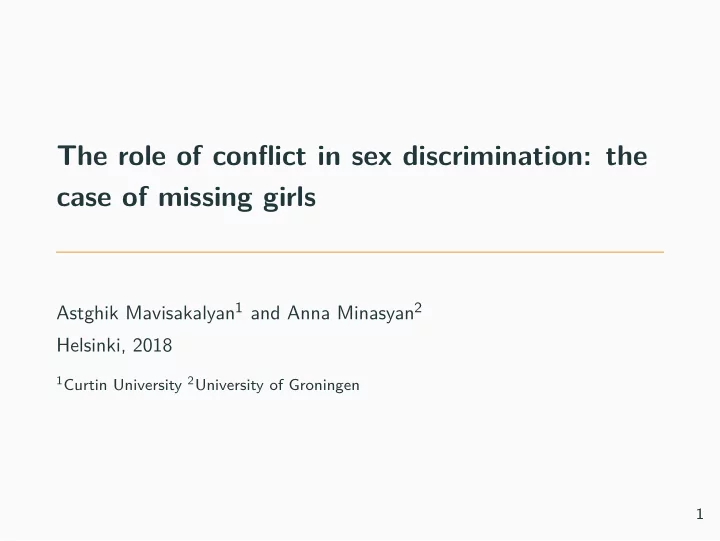

The role of conflict in sex discrimination: the case of missing girls Astghik Mavisakalyan 1 and Anna Minasyan 2 Helsinki, 2018 1 Curtin University 2 University of Groningen 1
1 Context and background 2 Individual-level analysis Data Method and results 3 Community-level analysis Data Method and results 4 Concluding remarks 2
Context and background
Missing girls - sex ratios at birth exceeding ~110 • natural sex ratios at birth: around 105 boys for 100 girls per 1000 births. • missing women - females who would be alive if their survival was not interrupted (Sen 1990) 3
Literature: reasons for missing girls • perception of males as the more productive sex (Ahn 1995). • women’s low earnings potential (Qian 2008). • old age support from male children (Das Gupta et al 2003). • patrilineal kinship systems (Ebenstein 2010).
Conceptual Framework 5
Nagorno-Karabakh conflict. • nagorno karabakh war 1992-1994 war unresolved; • many violations of ceasefire since 2008. • “an arms race, excalating front-line clashes, war rhetoric and a virtual breakdown in peace talks are increasing the chance armenia and azerbaijan will go back to war" (icg 2011) 6
Reasons for son preference: Armenia UNPFA 7
Hypothesis 1 - Individual level H1: Individuals highly concerned about conflict are more likely to express son preference. • Data: caucasus barometer wave 2010; population: individuals aged 18-80 • Method: bivariate probit model at the individual level 8
Hypothesis 2 - Community level H2: Exposure to threat of conflict leads to higher sex ratios (given fertility decline and access to ultrasound). • Data: 2001 and 2011 censuses; population: 76 communities; includes all the cities and towns, and the villages with over 5000 inhabitants. • Method: Community level differrence-in-difference • Periods: pre-ceasfire: 1987-1996 and post ceasefire: 1997-2001, 2002-2006, 2007-2011 • Treatment group: Communities closer than average to conflict center are in the treatment group, otherwise in the control group 9
Individual-level analysis
Armenian HH surveys, Caucasian Barometer, 2010 10
DV - Son bias: Probit marginal effects. Baseline. 11
Alternative DVs 12
Matching estimations 13
Community-level analysis
Distance to conflict and sex ratios at birth: Armenia 14
Treatment and control communities 15
Descriptive statistics 16
Parallel trends assumption 17
Difference-in-difference with linear time trends 18
Continous measure of distance 19
Robustness tests • Without outliers: • all post-ceasfire effects positive and stat. significant, increasing in each period • Treatment cut-off not mean but 25th percentiles: • Effects in 2nd and 3rd post-ceasefire periods strongest in the third period • Placebo: Distance not to Stepanakert but a North-West Armenian city Gumri, close to Turkey • Negative and small coefficient (-4.2* for the 3rd period) 20
Concluding remarks
Limitations and implications Limitations • External validity • Alternative conflict measures: fatalities • Emigration to Yerevan - selection on those who stayed back • ... Implications • Policies are needed to ensure gender-specific egalitarian values are in place in times of survival • Media and state counter-cyclical interventions • Ban on determination of sex? - Studies show not to be effective • Implemented in Armenia since 2016 21
Recommend
More recommend